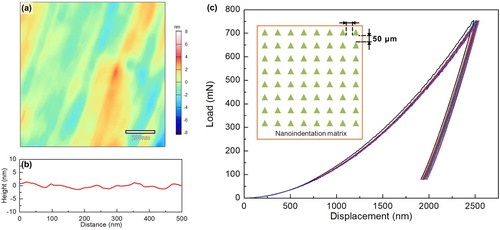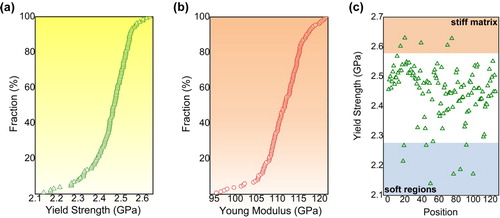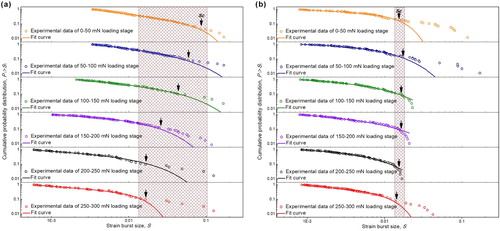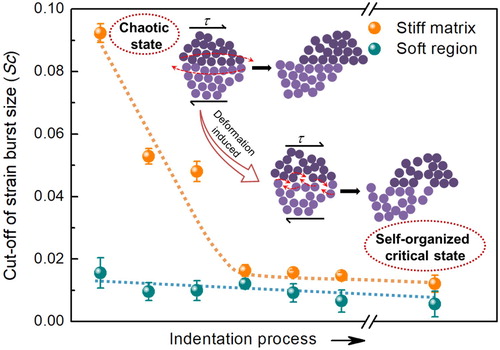 ?Mathematical formulae have been encoded as MathML and are displayed in this HTML version using MathJax in order to improve their display. Uncheck the box to turn MathJax off. This feature requires Javascript. Click on a formula to zoom.
?Mathematical formulae have been encoded as MathML and are displayed in this HTML version using MathJax in order to improve their display. Uncheck the box to turn MathJax off. This feature requires Javascript. Click on a formula to zoom.ABSTRACT
The imparities of shear avalanches dynamic evolution under nanoindentation originating from the soft regions and the stiff matrix were explored in a metallic glass by statistical and dynamic analysis. Upon the continuous indentation process, the dynamic state of the stiff matrix exhibits a transition from a chaotic behavior to a self-organized critical (SOC) behavior, whereas the soft regions are dominated by the SOC behavior throughout the indentation process. The mechanism was clarified by the evolution of the cut-off size of shear avalanches. These findings might advance our fundamental understanding of inhomogeneous deformation on microscale.
GRAPHICAL ABSTRACT

Impact statement
The shear avalanches dynamic evolution controlled by the atomic-scale rearrangement mechanism in metallic glasses strongly relies on the structural state and the history of deformation.
1. Introduction
Owing to the attractive combination of mechanical and physical properties, metallic glasses (MGs) are gaining significant ground as structural and functional materials [Citation1–4]. However, inhomogeneous deformation of MGs stemming from the lack of a long-range atomic periodicity leads to highly-localized shear banding, thus giving rise to the catastrophic failure, which severely restricts the application of metallic glasses [Citation5]. Therefore, the investigation and characterization of inhomogeneous deformation become essential to improve the ability of shear deformation in MGs. Inhomogeneous deformation of MGs is typically manifested as a series of spatiotemporal shear-banding behaviors that are known as repeat cycles of sudden stress relaxation, followed by re-accumulating elastic energy, i.e. the so-called shear avalanches or serrated flow [Citation6–8]. To reveal inhomogeneous dynamic deformation is particularly challenging in MGs because of the difficulty to conduct reliable and direct observations [Citation9].
Statistical and dynamic analysis of shear avalanches in MGs has been suggested as an important feature characterizing the plastic deformation mechanisms [Citation10–14]. Two distinct dynamical regimes have been identified. One is the chaotic dynamics characterized by finite degrees of freedom and sparse shear bands. The other is the self-organized critical (SOC) dynamics with infinite degrees of freedom and a large number of shear bands [Citation10–12]. Bian et al. [Citation13] adopted a statistical method for the normalized intermittent and abrupt events known as the strain burst size (S). Admittedly, the cut-off value of S (Sc), corresponding to the critical size of self-organized shear avalanches, was used to predict distributions and dynamics of shear avalanches [Citation14]. It was reported that the alloy compositions can dramatically change the value of Sc that demonstrates intrinsic ductility or brittleness of MGs [Citation13,Citation15]. The effect of strain rates on shear avalanches was studied by Ren et al. [Citation16]; a statistical analysis revealed that the serrated flow turned from a chaotic to a SOC behavior with the increasing strain rate. Although the dynamical regime and the Sc parameter are good indicators for studying the shear avalanches mechanism, the existing efforts for extracting the dynamics information are based on conventional testing on macroscale. The knowledge regarding the evolution of plastic dynamics upon the plastic deformation process, especially in brittle MGs, is still lacking. Especially, the deformation diversity of microscopic regions caused by heterogeneous structures is also ignored.
Structural heterogeneities are inherent in MGs [Citation5]. Generally, MGs can be regarded as a composite material consisting of the stiff matrix with densely packed atomic clusters and the soft regions with loosely packed defective clusters on microscale [Citation17]. Due to the fast dynamics of plastic deformation for MGs, the dynamics evolution on the microscale was often studied by molecular dynamics (MD) simulations [Citation18,Citation19]. The soft regions with abundant free volumes have lower atomic coordination than those in the stiff matrix, and could act as the preferential regions initiating structure destabilization under an applied stress, thus playing a key role in plastic deformation [Citation20]. In turn, during plastic deformation, shear-induced structural rearrangements accompanied with a dynamic change in the soft regions, were detected by MD simulations [Citation21], but lack experimental exploration. Even the simulation results can elucidate the variation behavior of soft regions in plastic deformation, the knowledge regarding the dynamic evolution behavior of the stiff matrix is still lacking because of the barren deformation information ascribing to short of free volumes.
Nanoindentation is known as an effective method to investigate the intrinsic properties at microscale with high accuracy [Citation22]. The technique has been extensively employed to discriminate structural heterogeneities and evaluate the mechanical heterogeneity in a variety of MGs [Citation22]. More importantly, plastic shearing can be stabilized due to the confinement from the surrounding material under nanoindentation, which provides adequate information to analyze the intermittent shear avalanches at various stages of deformation. In present work, the diversity of shear dynamic evolution under nanoindentation originating from mechanical heterogeneity was carefully explored. The dynamic evolution of shear avalanches and the related mechanisms in a MG were analyzed using both statistical and dynamic analysis. The insights gained could advance our fundamental understanding of shear avalanches operation down to microscale and this work might provide a new perspective for analyzing the physical and microscopic mechanisms behind complex serration data of various materials.
2. Experimental
A representative Ti45Zr16Cu10Ni9Be20 MG was selected. A 3-mm-diameter rod with a completely amorphous structure was prepared by the copper mold suction casting technique. The nanoindentation samples were mechanically polished to a mirror finish and the polished surface was examined by atomic force microscopy (AFM) (Asylum MFP3D). Nanoindentation tests were carried out using a Hysitron TI 950 system equipped with a Berkovich diamond tip (tip radius of ∼50 nm) in a displacement-controlled mode. The maximum depth of 2.5 μm was chosen to get enough data for evaluating dynamic evolution with the increasing indentation depth. Two arrays with 8 × 8 indentations were conducted to obtain statistically significant data sets. The intervals between these indentations were set to be 50 μm to avoid the plastic interaction between two adjacent indentations.
3. Results and discussion
The polished surface topography and the topographic profile of height was recorded by AFM (Figure (a,b)), indicating that the surface roughness is less than 2 nm. The indentation positions were carefully recorded and some representative load-displacement (P-h) curves are shown in Figure (c). From Bei et al. [Citation23], the strength will approach the theoretical strength asymptote for MGs without any defect. Accordingly, the density of defects in microstructure can be estimated by the ratio of measured strength and theoretical strength. In this way, the heterogeneous structures consisting of the stiff matrix and the soft regions in present work can be categorized by relative strength when compared with theoretical strength. In general, strength of certain MGs is about 1/3 of the nanoindentation hardness and the theoretical strength is about ∼1/50 of Young’s modulus of MGs [Citation24]. The corresponding cumulative probability distribution of strength and young modulus are shown in Figures (a,b). A large fluctuation of strength confirms the structural inhomogeneity in MGs [Citation22]. i.e. the minimum value of measured strength (2.13 GPa) is only about 70% of the theoretical strength (about 2.86 GPa here); while the maximum value (2.63 GPa) is close to theoretical strength. For convenience, the points with strength less (higher) than 80% (90%) of theoretical strength were represented as the soft regions (the stiff matrix) with excess (much less) free volumes, as shown in Figure (c).
Figure 1. (a) A roughness image of the polished surface. (b) Profiles of height with an average roughness of 2 nm. (c) The load vs. displacement curves of Ti45Zr16Cu10Ni9Be20 MG under a maximum displacement 2.5 μm. Inset of Figure (c) is a schematic diagram of the arrays with 8 × 8 indentations.

Figure 2. Cumulative distribution of strength (a) and modulus (b) corresponding to the load vs. displacement curves. (c) Distribution of strength for the stiff matrix (upper shaded area) and the soft regions (lower shaded area).

To identify the unclear serrated flow in the loading curves (Figure (c)), it is required to eliminate the influences from the increasing indentation depth and contact area on the intermittent deformation. First, a polynomial function that well describes the loading process was used to fit the displacement-time curves and serves as a baseline (Figure (a,b)). The distribution of serration events (Δh = hexp−hfit) relative to time was obtained through subtracting the baseline and eliminating the background noise. The background noise could be extracted from the holding segment at the peak load. In this work, the noise generated a shear step size of 0.4 nm. Figure presents both dynamic evolution in serration events of stiff matrix and soft regions. The corresponding quantity |Δh/Δt|, which unambiguously reflects the bursts of plastic activity, was calculated for clarification. For the stiff matrix shown in Figure (a1,a2), two different dynamic regimes could be identified. At the incipient stage of deformation (Figure (a1)), the shear burst exhibited roughly the same periodicity between any two neighboring serration events (i.e. tn-1≈tn≈tn+1), indicating a homogeneous distribution of shear avalanches and a chaotic behavior [Citation16]. For the late stage of deformation (Figure (a2)), an inhomogeneous time interval for neighboring serration events was detected, suggesting that serration events lack any typical time scale and belong to a SOC behavior [Citation16]. Thus, with the increasing indentation time/depth, a transition from a chaotic state to a SOC state has happened in the stiff matrix. While, for the soft regions shown in Figure (b1,b2), the time intervals between any neighboring serration events showed an inhomogeneous distribution (i.e. tn-1≠tn≠tn+1) in different deformation stages, which is consistent with the SOC behavior.
Figure 3. Polynomial function fitting (red solid lines) of the displacement-load curves for the stiff matrix (a) and the soft regions (b). Enlarged serration event-time curves at different stages: the incipient stage (a1) and the late stage (a2) of the stiff matrix; the incipient stage (b1) and the late stage (b2) of the soft regions.

Based on the stick-slip model, the serration events include an elastic energy accumulation process and a stress relaxation process [Citation14,Citation25]. For the stiff matrix, the energy accumulation time is much larger than the relaxation time
(
) at the incipient stage of deformation (Figure (a1)), suggesting that the stored elastic energy can be fully relaxed and spatial interference between adjacent serration events does not occur [Citation16]. In this case, nucleation and propagation of shear bands proceed in a more discrete manner. With the increasing indentation depth,
gradually decreases. Especially, the relaxation time approaches to the reloading time at the late stage of deformation (Figure (a2)). In this case, the accumulated force or energy needs a relatively longer time to relax, implying that the applied strain has to be accommodated via continuous operation of multiple shear bands. Due to the spatial interaction between shear bands, the accumulated elastic force in the serration events cannot be fully relaxed and the temporal correlation between neighboring elastic strain fields is enhanced [Citation26]. As a result, the serrated flow dynamics may self-organize to a critical state, featured by a collective motion of shear bands at the late stage of nanoindentation. For the soft regions, the stress relaxation time is commensurable with the stress accumulation time even at the incipient stage of deformation (Figure (b1)), and the dynamic state maintains always at a stable SOC state (Figure (b1,b2)).
To recognize the physical process underpinning the two diverse dynamic evolution processes, a statistical analysis is conducted to get more quantitative information as a function of indentation depth. The whole loading stage is divided into several sub-regions at a load interval of 50 mN. In each of the sub-region, the shear step size (i.e. the height difference between the peak and valley values in Figure ) can be calculated and the strain burst size S is generated through normalizing the shear step size by the indentation depth h [Citation10]. Figure shows the cumulative probability distributions of the strain burst size, P (<S). The cumulative probability distribution can be fitted by a power-law relation using Levenberg-Marquardt algorithm [Citation27]:
(1)
(1) where A is a normalization constant and the fitting parameter β is a scaling exponent. The distribution of strain burst size follows a power-law relation at the smaller S region. When the strain burst size increases to the cut-off value of S, the distribution fails out of the power-law relation. As shown in Figure (a), for the stiff matrix, the Sc decreases rapidly at the initial deformation stage from a high value of 0.0923 to a quite low value of 0.0147. Then the evolution of Sc becomes less distinct at the late stage of deformation (not shown here for brevity). It is well known that Sc indicates the ability to overcome the resistance of the jammed matrix to trigger shear bands [Citation13]. In other words, Sc can be regarded as a deformation unit size when the deformed area percolates with each other and gives rise to irreversible shear yielding. Thus, it can be understood that in the stiff matrix, the deformation unit size decreases with the increasing indentation depth.
Figure 4. Cumulative probability distribution of strain burst size of different stages for (a) the stiff matrix and (b) the soft regions. The variation tendency of Sc with indentation load (shaded areas) can be clearly identified.

The physical origin of the plastic deformation dynamic evolution processes can be disclosed by the atomic-scale operation mechanism, as schematically illustrated in Figure . It is accepted that nucleation of shear bands is strongly relied on the atomic-scale cooperative rearrangement and the free volumes generally act as the potential sites for deformation units [Citation26]. At the initial nanoindentation stage for the stiff matrix, the local plastic zone underneath the indenter is relatively small. The probability of finding potential sites for shear deformation is quite low in these regions with much less free volumes. Then long-range atomic cooperative operation and relatively large deformation units are needed for nucleation of shear bands [Citation28]. This corresponds to a large Sc as shown in Figure (a), being consistent with the fact that shear bands can only nucleate in a more discrete and chaotic manner. With the increasing indentation depth and contact area, the volume of material being indented becomes larger in the stiff matrix. More free volumes can be involved in deformation. On the other hand, with the continuous indentation processes, deformation in shear bands can change the surrounding atomic structure [Citation8,Citation29]. Xie et al. [Citation30] clarified the effect of structural softening and thermal softening on the serration behavior, and found that the excess free volumes could be formed by the shear banding through shear-driven atomic motion and local heating. Therefore, the operation of new shear bands can be preferentially initiated from the local regions with more free volumes. Due to the abundant vacancies available in free volumes, only local diffusion and short-range atomic rearrangement are needed for the shear deformation. This corresponds to a small deformation unit and a small Sc. In brief, the tough activation of atomic arrangement will be weakened by the continuous indentation processes.
Figure 5. Evolution of the cut-off value of the strain burst size (Sc) as a function of different deformation stages for the stiff matrix and the soft regions. The insets are the schematic illustration of atomic activation for shear deformation. Shear band is triggered through long-range atomic cooperative operation in the chaotic state but only local diffusion and short-range atomic rearrangement are needed in the SOC state.

On the contrary, there is no clear change of Sc for the soft regions during deformation (Figure (b)), indicating that the deformation unit size is independent of the indentation process. The abundant free volumes in the soft regions can act as preferred sites for shear deformation, and the easy activation of short-range atomic rearrangement enables a small Sc throughout the deformation process. The dynamic flow maintains at a stable SOC state, which is intrinsically dependent on the structure state but is no longer affected by the deformation history.
In summary, the measurements of strength show heterogeneous structures in MGs, i.e. the soft regions are surrounded by the stiff matrix. Upon the continuous indentation processes, a transition of dynamic regime from a chaotic behavior to a SOC behavior was identified in the stiff matrix. For the soft regions, a stable SOC deformation behavior dominated throughout the indentation processes. The cut-off size of shear avalanches in the stiff matrix was found to decrease with the increasing indentation depth, suggesting that the tough activation of long-range atomic rearrangements during shear bands formation is gradually weakened. The cut-off size of shear avalanches in the soft regions shows a quite weak relation with the indentation depth, which originates from the easy activation of short-range atomic rearrangement around the fertile free volumes. The present work implies that the existence of dynamic shear avalanches diversity in MGs, which strongly relies on the structure state and evolution of plastic deformation. This work could advance our understanding for imparities of plastic dynamics between the stiff matrix and the soft regions in the heterogeneous structure.
Acknowledgements
The authors would like to thank the Natural Science Foundation of China (No. 51801161), the Science Fund for Distinguished Young Scholars from Shaanxi province (2018-JC007) and the Fundamental Research Funds for the Central Universities (31020195C001).
Disclosure statement
No potential conflict of interest was reported by the author(s).
Additional information
Funding
References
- Byrne CJ, Eldrup M. Materials science: bulk metallic glasses. Science. 2008;321(5888):502–503. doi: 10.1126/science.1158864
- Wang WH, Dong C, Shek CH. Bulk metallic glasses. Mat Sci Eng R. 2004;44:45–89. doi: 10.1016/j.mser.2004.03.001
- Tian L, Wang XL, Shan ZW. Mechanical behavior of micronanoscaled metallic glasses. Mater Res Lett. 2016;4:63–74. doi: 10.1080/21663831.2015.1124298
- Bian XL, Wang G, Wang Q, et al. Cryogenic-temperature-induced structural transformation of a metallic glass. Mater Res Lett. 2017;5(4):284–291. doi: 10.1080/21663831.2016.1263687
- Su Q, Price L, Shao L. Dose dependence of radiation damage in nano-structured amorphous SiOC/crystalline Fe composite. Mater Res Lett. 2016;4(1):48–54. doi: 10.1080/21663831.2015.1103796
- Zhou Q, Du Y, Han WQ, et al. Identifying the origin of strain rate sensitivity in a high entropy bulk metallic glass. Scr Mater. 2019;164:121–125. doi: 10.1016/j.scriptamat.2019.02.002
- Klaumünzer D, Lazarev A, Maaß R, et al. Probing shear-band initiation in metallic glasses. Phys Rev Lett. 2011;107(18):185502. doi: 10.1103/PhysRevLett.107.185502
- Lewandowski JJ, Greer AL. Temperature rise at shear bands in metallic glasses. Nature Mater. 2006;5(1):15–18. doi: 10.1038/nmat1536
- Ma E. Tuning order in disorder. Nature Mater. 2015;14(6):547–552. doi: 10.1038/nmat4300
- Sun BA, Yu HB, Jiao W, et al. Plasticity of ductile metallic glasses: a self-organized critical state. Phys Rev Lett. 2010;105(3):035501. doi: 10.1103/PhysRevLett.105.035501
- Ren JL, Chen C, Wang G, et al. Dynamics of serrated flow in a bulk metallic glass. AIP Adv. 2011;1(3):032158. doi: 10.1063/1.3643218
- Sarmah R, Ananthakrishna G, Sun BA, et al. Hidden order in serrated flow of metallic glasses. Acta Mater. 2011;59(11):4482–4493. doi: 10.1016/j.actamat.2011.03.071
- Bian XL, Wang G, Chan KC, et al. Shear avalanches in metallic glasses under nanoindentation: deformation units and rate dependent strain burst cut-off. Appl Phys Lett. 2013;103:101907. doi: 10.1063/1.4820782
- Zhou Q, Du Y, Ren Y, et al. Investigation into nanoscratching mechanical performance of metallic glass multilayers with improved nano-tribological properties. J Alloys Compd. 2019;776:447–459. doi: 10.1016/j.jallcom.2018.10.270
- Kim J, Oh HS, Kim J, et al. Utilization of high entropy alloy characteristics in Er-Gd-Y-Al-Co high entropy bulk metallic glass. Acta Mater. 2018;155:350–361. doi: 10.1016/j.actamat.2018.06.024
- Ren JL, Chen C, Liu ZY, et al. Plastic dynamics transition between chaotic and self-organized critical states in a glassy metal via a multifractal intermediate. Phys Rev B. 2012;86(13):134303. doi: 10.1103/PhysRevB.86.134303
- Lu Z, Yang XN, Sun BA, et al. Divergent strain acceleration effects in metallic glasses. Scr Mater. 2017;130:229–233. doi: 10.1016/j.scriptamat.2016.12.017
- Takeuchi S, Edagawa K. Atomistic simulation and modeling of localized shear deformation in metallic glasses. Prog Mater Sci. 2011;56(6):785–816. doi: 10.1016/j.pmatsci.2011.01.007
- Scudino S, Sopu D. Strain distribution across an individual shear band in real and simulated metallic glasses. Nano Lett. 2018;18:1221–1227. doi: 10.1021/acs.nanolett.7b04816
- Derlet PM, Maaß R. Thermally-activated stress relaxation in a model amorphous solid and the formation of a system-spanning shear event. Acta Mater. 2018;143:205–213. doi: 10.1016/j.actamat.2017.10.020
- Chen Y, Jiang MQ, Dai LH. Collective evolution dynamics of multiple shear bands in bulk metallic glasses. Int J Plast. 2013;50:18–36. doi: 10.1016/j.ijplas.2013.03.010
- Ketov SV, Sun YH, Nachum S, et al. Rejuvenation of metallic glasses by non-affine thermal strain. Nature. 2015;524(7564):200–203. doi: 10.1038/nature14674
- Gao YF, Bei HB. Strength statistics of single crystals and metallic glasses under small stressed volumes. Prog Mater Sci. 2016;82:118–150. doi: 10.1016/j.pmatsci.2016.05.002
- Zhang P, Li SX, Zhang ZF. General relationship between strength and hardness. Mater Sci Eng A. 2011;529:62–73. doi: 10.1016/j.msea.2011.08.061
- Qiao JW, Sun AC, Huang EW, et al. Tensile deformation micromechanisms for bulk metallic glass matrix composites: from work-hardening to softening. Acta Mater. 2011;59(10):4126–4137. doi: 10.1016/j.actamat.2011.03.036
- Greer AL, Cheng YQ, Ma E. Shear bands in metallic glasses. Mat Sci Eng:R. 2013;74:71–132. doi: 10.1016/j.mser.2013.04.001
- Fu Z, Macdonald BE, Li Z, et al. Engineering heterostructured grains to enhance strength in a single-phase high-entropy alloy with maintained ductility. Mater Res Lett. 2018;6(11):634–640. doi: 10.1080/21663831.2018.1526222
- Packard CE, Schuh CA. Initiation of shear bands near a stress concentration in metallic glass. Acta Mater. 2007;55(16):5348–5358. doi: 10.1016/j.actamat.2007.05.054
- Jiang MQ, Dai LH. On the origin of shear banding instability in metallic glasses. J Mech Phys Solids. 2009;57(8):1267–1292. doi: 10.1016/j.jmps.2009.04.008
- Xie X, Lo YC, Tong Y, et al. Origin of serrated flow in bulk metallic glasses. J Mech Phys Solids. 2019;124:634–642. doi: 10.1016/j.jmps.2018.11.015
